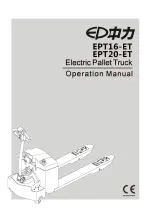
12
electrolyte should be added
。
1
.
4 The sulfuric acid electrolyte is prepared with battery sulfuric acid complying with the state standard
GB4554-84 and distilled water. Never use industrial sulfuric acid and running water. The standard
temperature
(
25
℃)
and density of the electrolytic solution can be converted as follows:
D25
=
Dt
+
0.0007(t
-
25)
D25
:
the density of the electrolytic solution at 25
℃
Dt
:
the density of the electrolytic solution at 25
℃
。
t
:
temperature of the electrolytic solution when testing the density
。
1
.
5 Dry up the electrolyte spilled on the surface of battery. Connect the positive and negative poles of
batteries with those of D.C. power source (charger) respectively and then turn on the power. Charge with the
current of 40 A (the current of the first stage). After the charge voltage achieves 28.8V (12×2.4V=28.8V), switch
to the 20A current of the second stage for continuative charge. When charging, the temperature of electrolyte
shall never exceed 45
℃
. When the temperature raising up nearly to 45
℃
, reduce the current by half or stop
charging temporarily. After the electrolyte temperature reduce below 35
℃
, continue charging. However the
charge time need to be extended appropriately
。
1
.
6 Fully charged basis
:
When the voltage during the second stage charging reaches 31.2V (12 ×2.6V =
31.2V), the variation of the voltage is no greater than 0.005 (V). The density of the electrolytic solution
reaches 1.280 ±0.005 (25℃), no apparent changes in 2 hours and there are fine air bubbles appear
violently, it can be deemed that the batteries are fully charged. The charged power capacity is 4-5 times of
the rated capacity and the charging time is about 70 hours.
1
.
8 In order to accurately control the sulfuric acid content of the electrolytic solution, the electrolytic
solution density of the batteries should be examined during the last period of charging. If there is inconsistence,
adjust with distilled water or sulfuric acid with a density of 1.40. The electrolytic solution density and the liquid
surface should be adjusted to the stipulated value within two hours in the charging state.
1
.
9 After the initial charging is completed, the surface of the batteries should be cleaned. Close the cover
of the open cover type liquid hole plug and then the batteries can be used
。
2 Use and maintenance
2
.
1 In order to guarantee the service life of the batteries, the batteries in use should be fully charged.
Insufficiently charged batteries must not be used. During the process of use, close attention should be paid to the
discharge extent. Over discharge is prohibited---the voltage reduces to 1.7V per battery (when the total voltage
reduces to 1.7V×12 = 20.4V ). When the density of the electrolytic solution reduces to 1.17, discharging should
be stopped and charging should be conducted at once. The batteries should not be placed idle for a long period
of time. The supplementary charging frequently conducted during the process of use is called common charge.
2
.
2 Common charge: The first stage current of common charge is 40A and that of the second stage is 20A.
The charging method is the same as that of initial charge. The charged volume is 130-140 % of the discharged
volume and the charging time is about 10 hours
。
2
.
3 The batteries in normal use should avoid over-charge, but over-charge must be properly conducted for
the batteries in following situation, i.e. balance charge
。
a. The “lag-behind” batteries——batteries with a voltage lower than that of the other batteries in the
charging and discharging process and the batteries having been repaired for failure. (When balance charge is
conducted, the positive and negative poles of the “lag-behind” battery should be respectively connected with the
positive and negative ends of the charger, the DC power supply, and the charge should be conducted
independently.)
b. Balance charge should be conducted for the batteries in normal use every 2-3 months
。
c. Balance charge should be conducted for the batteries that have not been used for a long period of time
before use.
2
.
4 Equalizing charge
:
a. Charge with a 4A current
。
b. When the charge voltage reaches 31.2V
(
12×2.6V=31.2V
),
and air bubbles occur in the electrolyte, the
current should be reduced by 50% (2A) and continue to charge.
c
.
When the batteries are fully charged, stop charging for 0.5 hour and charge again with 1A current for
one more hour.
d
.
Stop charging for another 0.5 hour and charge with a 1A current for another one hour
。
e
.
Repeat according to item d till air bubbles occur violently in the batteries once the charger is switched on
。
3 Keep and storage
The storage battery shall be kept in clean, dry and ventilated warehouse within the temperature range of
5 to 40
℃
. The valid storage period is 2 years. Safekeeping shall be made within storage period according
to the following requirements:
a. Avoid direct sunlight. The distance from heat source shall not less than 2m.















































